Planetary Trail and Radio Telescope Trail
The Effelsberg 100-m radio telescope of the Max-Planck-Institut für Radioastronomie (MPIfR) is located in a creek valley directly crossed by the border line between the states of Northrhine-Westfalia and Rhineland-Palatinate in Germany. It can be reached from a parking lot close to the two villages Lethert and Effelsberg, both parts of the town of Bad Münstereifel. From there it’s a walk of about 15 minutes to the visitors’ pavilion in sight distance to the telescope. Along the connecting road a topical astronomy trail has been assembled, the “Planetary Trail”, scaled 1 : 7.7 billion (1 : 7.7 x 109), covering the distance of 766 meters from the parking lot (panel “Pluto”) to the visitors’ pavilion (panel “Sun”). The Planetary Trail was built in 2004 and leads from dwarf planet Pluto and the outer gas giants in the solar system along the inner rocky planets including the Earth to the sun which is displayed as a concrete ball of about 40 cm diameter in the courtyard of the pavilion.
A virtual expansion of the Planetary Trail leading to one of the stellar neighbours of the sun, the bright star Sirius, has been completed. In the scale of the planetary walk Sirius will be in a distance of 11,000 kilometers – that’s the distance to the Atacama Pathfinder Experiment (APEX) in northern Chile. APEX is a partnership of the MPIfR with the European Southern Observatory and the Swedish Onsala Space Observatory. The virtual station "Sirius" of the Effelsberg Planetary Trail can be found at the back side of the APEX telescope.
The planetary trail is part of a more comprehensive trail that was installed in collaboration with the Tourist-Information/town of Bad Münstereifel and the Bad Münstereifel grouip of the Eifelverein.This “Radio Telescope Trail” leads over a distance of 13 kilometers from the centre of Bad Münstereifel and Rodert youth hostel to the visitors’ pavilion of the Effelsberg radio telescope. The distance from the youth hostel to the telescope is a bit less than 12 kilometers.
Since 2019, this hiking trail has been integrated into the concept of the “Eifelschleifen” (Eifel loops) and forms the Eifelschleife "Zum Radioteleskop" with a total length of 12.9 km from Bad Münstereifel to the Effelsberg radio telescope:
Eifelschleife „Zum Radioteleskop“
The last section of the Eifelschleife “Zum Radioteleskop” contains on a length of almost 800 meters 10 panels of the Planetary Trail, from dwarf planet Pluto to the sun. The radio telescope walk was marked with a green telescope symbol which was also displayed in the hiking map “Bad Münstereifel” (map no. 7 of the Eifelverein).
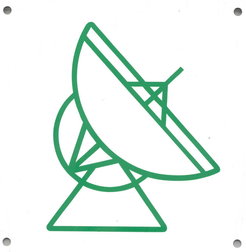
In the following we present information taken from the panels of the Planetary Trail:
Our solar system is displayed on ten panels at the route from the parking lot to the visitors’ pavilion. The resulting scale for the Planetary Trail is 1 : 7,7 billion. 1 cm corresponds to 77,000 kilometers or six times the diameter of Earth. In this scale Pluto is at a distance of 766 meters from Earth.
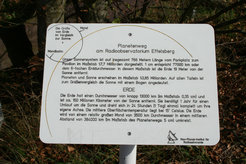
Planetary Walk at Effelsberg: Station "Earth".
The diameters of the planets are illustrated with scaled holes in the upper left of each panel. For a better display, the scale of these holes has been enhanced to 1: 3.6 billion. All panels show for comparison an arc with the diameter of the sun in the same scale.
At the General assembly of the International Astronomical Union (IAU) in August 2006 in Prague the term “planet” was defined a bit more accurately. According to the new definition there are eight planets in our Solar system (Mercury, Venus, Earth, Mars, Jupiter, Saturn, Uranus and Neptune), placing Pluto similar to Ceres in the asteroid belt between Mars and Jupiter and also Eris, discovered in 2005, into the newly defined category of “dwarf planets”. In our planetary walk the dwarf planet Pluto is still marking the starting point at the parking lot. In the talks at the visitors’ pavilion the mnemonic for the planets in the solar system has been slightly changed: "My Very Excellent Mother Just Served Us Nachos" (instead of “Nine Pizzas”).
In 2018, the Planetary Trail at the radio telescope near Effelsberg has been considerably expanded:
Astronomy Walks in Effelsberg – how Sirius is coming to Chile
Sirius, the brightest star in the night sky, is one of the nearest neighbours of the sun in a distance of 8.6 light years. In the scale of the Planetary Trail (1 : 7.7 billion) that corresponds to a distance of 11,000 km or almost exactly the distance of two of MPIfR’s radio telescopes: the 100-m radio telescope near Effelsberg and APEX in the Chilean Atacama desert, 5100 m above sea level. Including Sirius, the Planetary Trail at Effelsberg is probably the longest astronomical trail in the world.
In the scale of the Milky Way Trail (1 : 100 quadrillion, or 1 : 1017), however, both stars (Sun and Sirius) are only 90 cm apart: Milky Way Trail.
Page 2: Description of the stages of the Planetary Trail.
Pluto
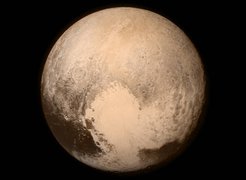
The Planetary Trail starts with dwarf planet Pluto. Its average distance to the sun is almost 6 billion kilometers. Pluto has a diameter of only 2300 km (scaled 0.64 mm) and is thus even smaller than our moon (3476 km).
A full rotation of Pluto around the sun takes 248 years. A day on Pluto, that is a complete rotation around its axis, corresponds to 6.5 days on Earth. The surface temperature of Pluto is 40 Kelvin or -233 degrees Celsius. Pluto is accompanied by its large moon Charon. Both show a synchronous rotation thus facing each other all the time.
Pluto was discovered in 1930. In November 2005 two small moons of Pluto (Nix & Hydra) have been found. In 2011 and 2012 two more moons of Pluto were found with the Hubble telescope (Kerberos & Styx). Altogether five moons are orbiting the dwarf planet Pluto.
Neptune

Neptune, the outermost planet, is a gas giant. The diameter is nearly 50,000 km (scaled 1.37 cm) and its average distance from the sun amounts to 4.5 billion kilometers.
It takes 164 years for a full orbit of Neptune around the sun. A day on Neptune is shorter than a day on Earth; it takes only 18 hours for a full rotation around its axis. The cloud temperature fluctuates around -170 degrees Celsius. At the moment (February 2024), 16 moons orbiting Neptune are known.
Neptune was detected by Johann Gottfried Galle in Berlin in the year 1846.
Uranus
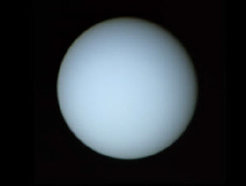
Uranus is also a gas giant with a diameter of more than 50,000 km (scaled 1.42 cm). Its average distance from the sun is 2.9 billion kilometers.
A complete orbit of Uranus around the sun takes 84 years. A day on Uranus is 16 hours long. The average cloud temperature is -193 degrees Celsius, thus lower than Neptune’s. At the moment (February 2024), there are 28 moons known orbiting Uranus.
Uranus was discovered by Friedrich Wilhelm Herschel in the year 1781.
Saturn
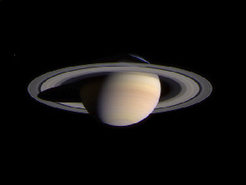
The ring planet Saturn is also a gas giant with a diameter of 120,000 km (scaled 3.35 cm) Its average distance from the sun is 1.4 billion kilometer.
A full orbit of Saturn around the sun takes 29 years, a day on Saturn is only 10 hours long. The average cloud temperature is -125 degrees Celsius. At the moment (June 2023) there are 146 moons known.
The planet Saturn was already known in ancient times and it can be seen with the unaided eye in the night sky.
Jupiter

Jupiter is the largest planet in the solar system. It has a diameter of 143,000 kilometers (scaled 4.0 cm) and is in an average distance of 780 million kilometers from the sun.
A full orbit of Jupiter around the sun takes 12 years, a day on Jupiter is only 9 hours long. The average cloud temperature is -120 degrees Celsius. At the moment (June 2023) there are 95 moons known, the highest number for any planet in the solar system.
The planet Jupiter was already known in ancient times and it can easily be seen with the unaided eye in the night sky.
Mars
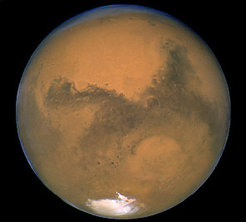
Mars is the outer neighbour of the Earth in the solar system. It has a diameter of 6,800 kilometers (scaled 0.2 cm) and is at an average distance of 230 million kilometers from the sun.
Mars takes about two years for an orbit around the sun. A day on Mars is slightly longer than a day on Earth. The surface temperature on Mars is -63 degrees Celsius on average. Mars has two moons, Deimos and Phobos, both pieces of rock with only a few kilometers in diameter.
The planet Mars was already known in ancient times and it can easily be seen with the unaided eye in the night sky.
The Earth
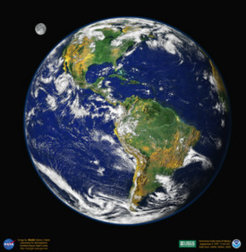
Our Earth has a diameter of slightly less than 13,000 kilometers (scaled 0.35 cm) and is at an average distance of 150 million kilometers from the sun.
The duration of one of Earth’s orbits around the Sun defines the year and the 24 hours it takes for a full rotation around its axis defines the day. The average temperature on Earth is +15 degrees Celsius. The Earth is accompanied by a large moon of 3,500 kilometers in diameter with an average distance of 384,000 kilometers (scaled: 5 cm).
Venus
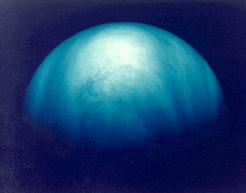
Venus is the inner neighbour of the Earth in the solar system. Its diameter of approximately 12,000 kilometers (scaled 0.34 cm) make both planets twins, but only in size. Venus is at an average distance of 110 million kilometers from the sun and takes 224 days for an orbit around it. A day on Venus is even longer than the Venus year: 243 days. The surface temperature is +482 degrees Celsius on average. Venus has no known moons.
The planet Venus was already known in ancient times and it can very easily be seen with the unaided eye in the night sky (morning star or evening star – both are designations for Venus).
Mercury
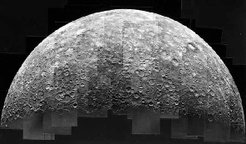
Mercury is the planet closest to the sun. It has a diameter of a bit less than 5,000 kilometers (scaled 0.14 cm) and has a distance of 58 million kilometers from the sun.
Mercury takes 88 days for an orbit around the sun. A day on Mercury is as long as 59 days on Earth. The surface temperature changes between +430 and -170 degrees Celsius, with an average value of +180 degrees. Mercury has no known moons.
The planet Mercury was already known in ancient times but it is difficult to observe because of its proximity to the sun.
The Sun
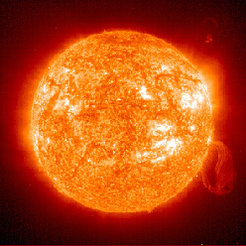
The sun is the central body of our solar system. Its diameter is 1.4 million kilometers (scaled 39 cm) with a surface temperature slightly below 6000 degrees Celsius.
The energy of the sun is created by nuclear fusion of Hydrogen to Helium in its centre with a reservoir for more than 10 billion years in total.
The nearest stellar system, Alpha Centauri, is at a distance of 4.3 light years, or 5300 km in the scale of the planetary walk.
Sirius

Sirius, the brightest star in the night sky, is twice as heavy as our sun and would shine 25 times brighter at the same distance. Sirius is 8.6 light years away from the sun, or 11,000 kilometers in the scale of the planetary walk. This corresponds well to the distance between APEX in Chile and the Effelsberg radio telescope in Germany.
Since September 2019, the Sirius station of the Effelsberg planetary walk is mounted at the APEX radio telescope in the Chilean Atacama desert.
Picture Credit
The pictures of the sun and the planets were predominantly taken from NASA’s Astronomy Picture of the Day (APOD) archive:
Moons in the Solar System
The number of known moons for the large diameter gaseous planets in the solar system (Jupiter, Saturn, Uranus and Neptune) is steadily growing. Planetary probes like Voyager 1 and 2, Galileo and Cassini, but also improved observing techniques from Earth-bound observatories have allowed the discovery of small bodies with only a few kilometers in diameter.
Detailed tables containing brightness and orbital parameters of the moons in the solar system are available via The Giant Planet Satellite and Moon Page (maintained by Scott Sheppard).












